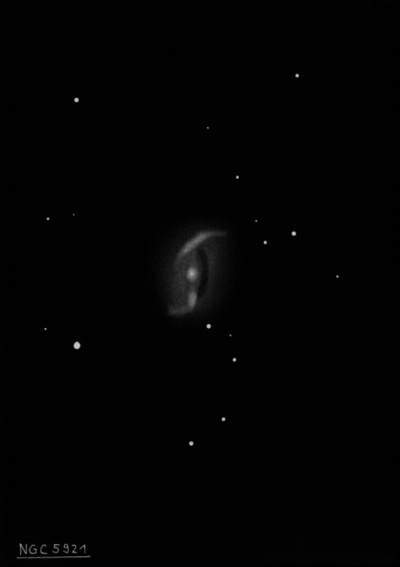
William Herschel discovered NGC 5921 = H I-148 = h1919 on 1 May 1786 (sweep 561) and recorded "cB, cL, bM, iR. Stars scattered over and about it; not belonging to it." His position is accurate. On 17 Apr 1855, LdR's assistant R.J. Mitchell, logged "suspect spiral like an 'S'. Mr J. Stoney saw the np branch with considerable certainty, the sf one not so sure."
A photograph (3-hour exposure) with the Crossley reflector was included in the October 1912 Publications of the Astronomical Society of the Pacific. Curtis described NGC 5921 as a "very interesting spiral. Fairly strong nucleus, about which is an oval 1.8' long, whose longer axis is crossed by a straight lane of matter; from the ends of this oval spring the two main whorls of the spiral; other fainter whorls are visible."
400/500mm - 17.5" (7/16/93): fairly bright, fairly large, elongated 3:2 N-S, 2.0'x1.4', small bright core dominates, stellar nucleus. Located 2.9' WNW of a mag 9.5 star. A mag 12 star is just at the SW edge 1.1' from center. This star is at the end of a distinctive arc of four mag 11-12 stars leading to the galaxy on the south side.
600/800mm - 24" (7/25/14): at 260x, this multi-armed barred spiral appeared bright, fairly large, elongated 3:2 ~N-S, sharply concentrated with a striking, very bright core. A slightly brighter bar (fairly low contrast) extends SSW to NNE. The very beginning of a spiral arm is evident as an elongated glow at the north end of the bar, extending a very short distance to the northwest. The view was improved at 385x with a strong hint of a second spiral arm beginning at the south end of the bar and starting to bend east. Contains a bright, sharp stellar nucleus. A mag 10 star is 3' SE and a mag 12 star is at the southwest edge.
900/1200mm - 48" (5/1/19): at 545x; superb barred ring spiral, very sharply concentrated with an intense, round nucleus. The central 1.25' bar was easily visible extending SSW-NNE, and displayed a pretty even surface brightness. A fairly low contrast circular ring was visible enclosing the bar and nucleus. The northern spiral arm was attached at the north end of the bar and curled clockwise, extending west for ~1.5'. A prominent southern arm was fairly straight as it extended 1.25' ESE from the south end of the bar (at a right angle). The diffuse eastern part of the halo had a low, but irregular surface brightness. A mag 12.0 star is at the southwest side, 1.2' from center and a mag 10.3 star is 2.9' SE. A curve of stars extends directly south of the galaxy and a number of stars are close west.
UGC 9830, located 36' SSE, appeared faint, fairly large, extremely thin edge-on, ~10:1 SW-NE, ~1.5''x0.15', very low nearly even surface brightness. A mag 13.6 star is attached at the east edge near the center and detracts from viewing.
Notes by Steve Gottlieb